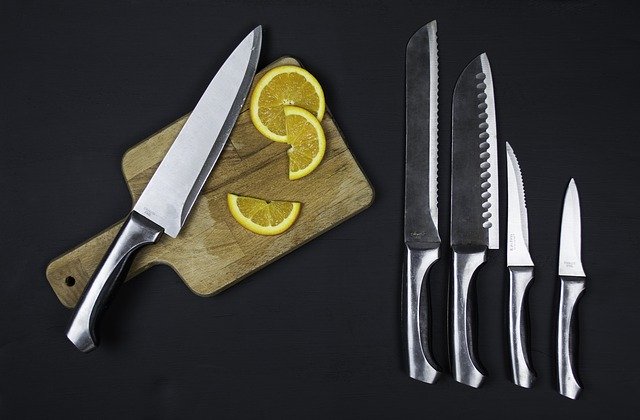Types of Kitchen Knives and their Uses
Anyone who has prepared food even once in their life would know how important knives are for cooking. Used for cutting, slicing, dicing, mincing, and a range of other purposes, kitchen knives have carved an irreplaceable place for themselves in any household.
If you are looking for a knife that would fit your desired purpose to a tee, take a look at this list of different kitchen knives and their uses before purchasing a knife set for yourself.
Chef’s Knife
As the most commonly used kitchen knife, the chef’s knife is a mandatory presence in any kitchen set.
Because of its comfortable size and grip, as well as the perfectly shaped board blade, it can be used to cut a wide variety of ingredients, including but not limited to slicing meat, dicing onions, and chopping fruits.
Utility Knife
Shorter in length than the chef’s knife, the utility knife is also called a mini chef’s knife. It is also similar in functionality to its bigger version, being able to slice meat and vegetables that are usually considered too small for the chef’s knife to properly cut.
Santoku Knife
Its name implies its function: “three virtues”, which in this context are slicing, dicing, and cutting. Despite being shorter than a regular chef’s knife, it can perform the same basic functions.
According to Knifegeeky, it is specifically used for slicing skinnier vegetables that the chef’s knife can sometimes struggle with. This Japanese knife is usually preferred by chefs who are fond of smaller blades with a more tender touch.
Kitchen Shears
Not knives per se, but still considered a major part of a kitchen knife set. The shears are scissors that are used to cut down excess parts of fruits or vegetables, usually the top outer portion.
They also help mince herbs and is the go-to choice for garden work. The kitchen shears are also useful for quickly cutting sections of chicken or cutting onions or garlic when in a hurry.
Cleaver Knife
Perhaps the scariest looking of the bunch, the cleaver performs the most hard-hitting tasks among the knife family.
From cutting through bones or slicing meat from ribs, the cleaver is a must-have for butchers and any chefs working with raw meat, especially beef and mutton.
Paring Knife
Preferred for extremely accurate cutting, the paring knife requires precision to use. It can peel fruits and vegetables, skim excess fat from meat, and get skin or shell off smaller fishes or shrimps.
The blade is usually only three to four inches in length and is considered one of the smaller knives in a kitchen set.
Bread Knife
Implied in its name, the bread knife contains a long saw-like blade that helps to effortlessly cut bread without damaging the structure of the loaf. They are usually six to seven inches tall and is distinguished by its narrow shape, which is designed for slicing through bread easily.
Boning Knife
When it comes to separating bones from raw meats, this is the knife you need. The narrow blade and the curved bottom allows easy separation of bones, specifically without damaging the meat in the process.
Boning knives come in both flexible and stiff blades: the former preferred for fish and chicken, while the latter is best for deboning heavier meat like beef.
Steak Knife
Typically seen in the table of a big feast, the steak knife is specifically used for cutting cooked portions of chicken, beef, pork, and meat of all varieties.
Chefs also prefer steak knives for cutting salads and sometimes even for spreading butter.
Learn to Categorize Your Knives Today!
All knives should be separated based on their functionality, and educating yourself on its types can not only help you avoid any mishaps in the kitchen but also help you slice and dice like a pro!
And with the help of this article, you too can whip up a plethora of large and complicated recipes in a jiffy!

